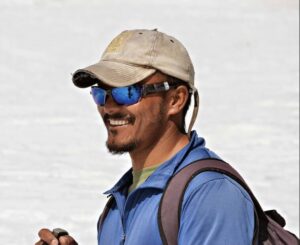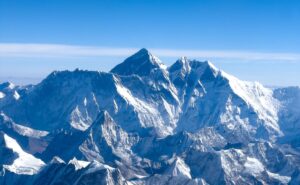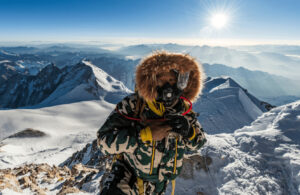Thanks to a successful helicopter longline rescue this morning, Tim Bogdanov and Giampaolo Corona are safe and under medical care in a hospital in Kathmandu.

A helicopter longlines a stricken climber this morning on Annapurna. Photo: Kailash Helicopter Services
Bogdanov and Corona summited Annapurna without supplemental oxygen and without Sherpa support. According to The Himalayan Times, Corona lost contact with Base Camp for a second time yesterday, after a rescue helicopter spotted him earlier on Friday morning. Reportedly, Corona was going down by a “new” route, which probably means that he had just lost his way during the descent.

The helicopter spots one of the climbers in trouble. Still from a video shot by Chhang Dawa Sherpa
A few hours later, Chhang Dawa Sherpa of Seven Summit Treks posted on social media that a helicopter extracted both climbers by longline, Bogdanov first, then Corona.
Kailash Helicopter Services added today that the rescue took place at Camp IV, at 6,800m. Earlier reports stated that the two climbers were picked up considerably higher, at 7,400m-7,500m. Confusion has characterized the last two days.

Frostbitten but alive
The helicopter flew Bogdanov and Corona to the hospital in Kathmandu. They are frostbitten but stable. As we can see from the photos below, Corona frostbit his hands and his nose, while Bogdanov frostbit both hands.

Left, Captain Alastair Hopper of Kailash Helicopter Services. Right, Giampaolo Corona with frostbitten hands and nose. Photo: Chhang Dawa Sherpa
From the hospital, a grateful Bogdanov thanked his outfitter and his rescuers. “Because of you all, Annapurna has fewer casualties these years,” he wrote.

Tim Bogdanov with frostbitten hands, but safe. Photo: Tim Bogdanov
Approximately 30 people summited Annapurna, including four without O2. Besides Corona and Bogdanov, Hans Wenzl of Austria also used neither supplemental oxygen nor Sherpa support. We have no information about his condition yet, only that he summited. Grace Tseng of Taiwan also claims a no-O2 ascent.
According to Juan Pablo Sarjanovich of Argentina, who had left the mountain earlier after deciding not to try for the summit, all the climbers have now returned to Base Camp. That’s it for Annapurna for this season: The Sherpas will pack up Base Camp shortly.
Says Sarjanovich: “It is necessary to choose which battle you want to fight…Without Sherpa assistance and without O2, I am still not at the level of Annapurna.”

A whiteout on Annapurna. “One of the most terrible and scariest moments of my life,” recalled Allie Pepper. Photo: Allie Pepper
There are no details about the unnamed Indian climber who was rescued yesterday from Camp 3. The last information we have stated that he is in the hospital in Kathmandu, suffering from AMS and in critical condition when he arrived.
A total of three climbers needed rescue.

The hard upper section of Annapurna. Photo: Adriana Brownlee
Photos and details emerge of the summit push
Norwegian Kristin Harila, who is trying to climb all 14 8,000’ers in six months, thanked the three Sherpas who accompanied her to the summit, Dawa Sherpa, Lakpa T. Sherpa, and Lakpa Norbu.

Kristin Harila and Sherpas on the summit. Photo: Kristin Harila
Australian Allie Pepper said this afternoon on Instagram that she believes that she is the third Australian to summit Annapurna. The summit push was hard and very long, she admits. It started at 6,800m.

Allie Pepper shows her position on the summit of Annapurna. Photo: Allie Pepper
Pepper did not use oxygen until 7,800m. At that point, she realized that she was going too slowly to summit, and the weather was worsening. She had either to turn back or use the emergency oxygen that Dawa Sherpa was carrying for her. She chose the oxygen.
“What would have taken me five hours [without oxygen] took two hours [with it]. It was like a superpower! I was suddenly warm, could climb without stopping, and could talk,” she recalls.

Allie Pepper used emergency oxygen after 7,800m. Photo: Allie Pepper
At 7,900m Pepper and her companions were caught in a snowstorm, with lightning and a whiteout. Pepper says that they sat for two hours, getting blasted by snow, and could not see a metre away. Pepper and her Sherpas eventually topped out on April 28, at 3:50 pm.
Somehow, Dawa Sherpa managed to find the way back to the fixed rope in the dark, through deep snow. They met a group that had gotten lost and showed them the way. Two in that group, Bogdanov and Corona, later became lost again. After the 22-hour-long summit day, she says that she now understands why Annapurna is such a dangerous mountain.

Allie Pepper tops out on Annapurna. Photo: Allie Pepper
A second whiteout
One member of 8K Expeditions recalls that they had summited at 4:31 pm. Then, during the descent, a squall hit, creating another whiteout. They could not find the way for six or seven long hours. Finally, they picked up the route.

Baibanou Bouchra of Morocco on the summit of Annapurna. Photo: Baibanou Bouchra
Some climbers decided to retreat just 150-200m below the summit. One of them, Arjun Vajpai of India, turned around with 150m to go because of frostbite on both feet.

Gelje Sherpa and Adriana Brownlee celebrate on the summit on Annapurna. Photo: Adriana Brownlee






